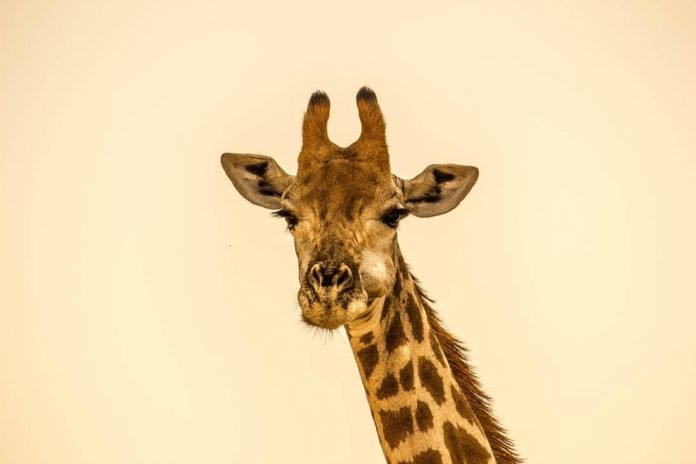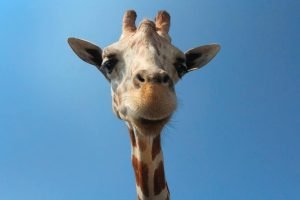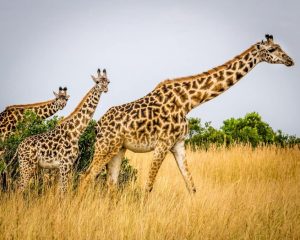
Giraffes, those majestic, beautifully spotted creatures of the land, are definitely a sight to see when you go to a safari in Africa- these animals are a widespread scene in pastures and open groves in East Africa, where they can be glimpsed in reserves such as Tanzania’s Serengeti National Park and Kenya’s Amboseli National Park. Before we get to why you’re really here, which is to know why the giraffes have horns, let’s quickly have a glance at the physical characteristics of these gigantic animals- their height, weight, etc.
Giraffe, (genus Giraffa), any of four ancestries in the genus Giraffa of gigantic-necked cud-chewing hoofed mammals of Africa, with tall legs and a coating structure of jagged brown putters on a pale background are gigantic of all soil animals.
The males may overstep 5.5 meters (18 feet) in length, and the massive females are approximately 4.5 meters in height. Utilizing prehensile tongues nearly half a meter long, they can examine foliage about six meters of the ground.
Isn’t that surprising? Giraffes, by the age of about four, grow roughly to their enormous size; however, bulking and gaining of weight doesn’t happen until seven to eight years of age. The adult male giraffes weigh up to 1,930 kg (approx 4,300 pounds) while the females weigh up to 1,180 kilograms (approx 2,600 pounds). They have a long black cluster on edge, and the bottom may be a meter in height; there is also a small ebony mane.
Both sexes have a couple of horns, though males also possess other bony lumps on the dome. But why do giraffes have horns, anyway? We’re not completely sure- although there are a couple of reasons why giraffes may have horns- the major ones are defense and fighting in necking wars. It is also possible that the giraffe horns are the remaining outcroppings of their ancestors that were believed to possess much larger horns (antlers), much like antelopes and deer of the existing age.
Why do giraffes have horns?
Giraffe horns are not known as horns, but ossicones and both female and male giraffe possess them, and both female and male giraffes have a whole set of ossicones. Ossicones are structures that are cropped up from ossified cartilage and are enclosed in a membrane- Giraffes are born with these ossicones, and these aren’t structures that develop later in order to help the giraffe adapt to its surroundings; however, the ossicones aren’t completely fixed to their skull and are not fastened to the crown to stave off damage at the time of birth- they only link with the head later in life.
While female ossicones are often delicate and tufted, male giraffes commonly have rawer ossicones that become barren on top as an outcome of periodic necking. In some species, males grow an additional set of ossicones behind the first pair, as well as distinguished ossicones in front of the directing battalion. The additional set of ossicones on the giraffe allocates them into diverse species- the male adult Northern and Reticulated giraffe have regular median ossicones while the Masai and Southern giraffes don’t.
What’s the purpose of the ossicones on the giraffe?
The ossicones on the giraffe’s head may be there for several reasons; however, we aren’t completely sure why.
Ossifications on male giraffes’ head enhance weight, which often improves with age, facilitating them to transmit ever more enormous bangs during necking wars. Aforementioned, it is believed by the biologists that the giraffe’s ancestors possessed antlers that have now been reduced to merely ossicones in the giraffes of the existing era since the antlers are of no use to the giraffes anymore (it is believed that the ancestors used antlers to defend against even bigger and powerful animals, possibly dinosaurs).
Antlers are composed of projections of bone that fall off (in a way) and regrow every year. However, the giraffe’s “horns” are not antlers – they are continual outcroppings of bone from the skull, referred to as “ossicones.” Giraffes’ ossicones are wrapped with hair (besides the adult males, whose coat of hair degenerates at the end and the bare ossicones are visible at the end).
The good guess is that the giraffe’s “horns” originally aided patterns for their antlers — sockets that benefited the vast receptacles which deer encounter so conveniently during the coupling season in their trials of vitality and authority.
Giraffes joust by draping their necks around each other and thumping the back of their skull, and sometimes their forehead, into the head of their partner because the brutal frontal onslaughts with horns could have been way more lethal and hazardous (also unnecessary) since giraffes have a thin neck and as the neck gets thin with their growing height, it also becomes weak and more vulnerable.
Thus, giraffes further have bony protrusions above their eyes and at the back of their heads. But this technique of combatting antlers at the top of the head is not that useful- there’s a strong chance that it was partly because of this that giraffes lost their horns. But it is feasible that the bone structures which assisted those horns were not forfeited so effortlessly – arising in ossicones.
Spandrels provided confirmation of evolutionary by-products, information that creatures are not constructed from the floor up but modified and changed course over time. Sometimes, spandrels discover a fresh, secondary purpose. It may be possible that the ossicones of the giraffe are present on the head for none of the reasons above but a different purpose altogether, which is yet to be discovered and understood by the biologists.
However, it also may be that they are evolutionary debris – examples of the unusual side-effects generated as evolution fiddles with a limited thousand genes to make the vicious variation of biological aspects we call life.

What do we call the horns of giraffes?
The actual name is “Ossicones.” The term ossicone implies “bony cone.” It’s a bony tissue, but it’s sluggish than the severe type of bone we would uncover inside a limb or the neck.
They are also referred to as:
- Horns
- Antennas
- Antlers
- Bumps
- etc.
People don’t really say ossicones because not a lot of animals possess it while it is also hard to pronounce, so it’s much susceptible to call them horns or antlers.
How do you pronounce the word “Ossicones.”
The initial part of the word is pronounced like the word “Ossi,” and the latter part is pronounced like “Jones” with a “C.”
So when plopping the two words jointly, you assert it as “ossicones.”
What are the “horns” made of, and what do they feel like?
Ossicones are constructed from ossified cartilage and are wrapped in skin. Giraffes are born with their ossicones; however, they lie steady and are not affixed to the skull to avert destruction at birth. They only mesh or link with the head later in life.
Both female and male giraffes have a prominent pair of ossicones. While female ossicones are often tiny and tufted, male giraffes naturally have broader and larger ossicones that become barren on top as an outcome of systematic necking. In some species, males develop a second pair of ossicones behind the first pair, as well as distinguished ossicones in front of the steering squad.
The horns are composed of cartilage, which is more adaptable than bone, but it’s still firm. It also originates inside the mortal ears. So it’s not an antler, and it’s not horned either. The cartilage element is not generally found inside horns but inside ears and delicate portions of the body.
Outside the ossicones, you find an excellent layer of skin and fur just like we see it on the rest of the giraffe’s body. It’s intriguing why the giraffes all have skin growing outside these ossicones, and it may be a clue hidden here.
The ossicones are not rigid like horns and are coated with a membrane, so they are not like antlers. They are carved up of soft bony tissue, and as the baby giraffe grows taller, they will affix to the skull. When the giraffe is born, however, the ossicones are not connected to the crown. We speculate the rationale for this is to safeguard them from smashing and doing harm to the little baby’s head.
When you feel ossicones, they are soft and steady, precisely like the legs of the giraffe. This is also one of the significant distinctions between the ossicones of the giraffe and real horns. Because they are enclosed with a membrane and are sluggish; they are not like the original horns at a

Which other animals have ossicones?
- Sivatherium
- Climacoceratids
- Climacoceras
As you can easily assert from these names that these animals are defunct, so biologists did not really care to provide them with original characters and titles.
The Sivatherium certainly looks like the excellent combination between an okapi and a giraffe, only with much larger horns than both of these animals that share its resemblance. This might be the substantial reason why giraffes have horns- because this antique relative did have long horns or antlers, and when it formulated into a giraffe, the horn didn’t fade away. Instead of degenerating completely, they only grew smaller and look like the ones we locate on the top of the giraffe’s head today.
What are giraffes related to?
Giraffes are not the only creature with ossicones. Guess we have others in the group as well. The nearest relative to the giraffe is the “okapis.” They have tiny horn-like antlers at the semblance of its head. Other than that, it’s not really susceptible to confide that this creature is the closest relative to that giraffe. It’s a lot tinier and looks more like a horse or maybe a short deer.
The male okapis also have ossicones on their skull. The female okapis do not have these horns on their heads, unlike the giraffes. For the giraffes, however, you will recognize them from the males as well as the females. Nobody really comprehends why we will not discover them horns on the female okapis.
Besides the two horns, the okapi and the giraffe also have something else in common: A very long dark-colored tongue. They both have a relatively standard language, which feels comic. You might have discerned it in the zoo when the giraffe juts out its long tongue to clutch food from your hand.
How do giraffes protect themselves?
Grown-up giraffes’ size frightens many probable buzzards, so young and ignorant giraffes are more susceptible to danger. The giraffe’s chief potent defensive asset is a mighty kick it puts on with its front feet, with pressure powerful enough to slay a lion. Giraffes have no claws, sharp tusks, but they have edged antlers to safeguard themselves. Any creature that resides in the violence in such circumstances has modifications that enable them to withstand the dangers and survive in their habitat. Giraffes utilize these antlers or ossicones to uphold and protect themselves from intruders and, sometimes, their legs. These are the fundamental and most dominant ammunition that protect them from death
During assaults, male giraffes swivel their heads at each other, attempting to get their foe to waive and run away from the area. These ossicones (horns of giraffes) started up as cartilaginous structures; however, over time, the cartilage is rehabilitated by bone, and the horns become very tough and reliable. Giraffes are the only gigantic living terrestrial animals, and some of the widest specimens reach approximately 20 feet in height. Giraffes have developed long necks to see predators from a tremendous distance and to get their favorite food sources. Giraffes eat up a wide variety of plant species, but the famous diet for giraffes is the fresh, tender leaves in the caps of acacia trees. Giraffes need vast and potent hearts to pump blood up to their necks and into their brains.
The giraffe can certainly swivel it’s long neck rapidly and whack any animal. It can even blow out big cats to protect itself, so they become inanimate or senseless for a bit of time. This enables the giraffe to take flight before the predator wakes up again. As the giraffe swings his head, these tiny horns reinforce additional weight (and therefore different speed) to the swing. So it might be a benefit for the giraffe to have them even though they might look silly and not seem crucial. We don’t speculate the giraffe utilizes the little horns promptly to protect itself. They are enclosed with membrane and are not spiked like antlers and real horns. So we can’t really wield them to injure another animal.
Read More






